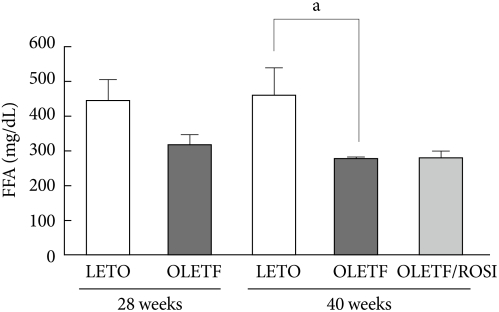
- Current
- Browse
- Collections
-
For contributors
- For Authors
- Instructions to authors
- Article processing charge
- e-submission
- For Reviewers
- Instructions for reviewers
- How to become a reviewer
- Best reviewers
- For Readers
- Readership
- Subscription
- Permission guidelines
- About
- Editorial policy
Articles
- Page Path
- HOME > Diabetes Metab J > Volume 34(4); 2010 > Article
-
ResponseResponse: Effects of Rosiglitazone on Inflammation in Otsuka Long-Evans Tokushima Fatty Rats (Korean Diabetes J 2010;34:191-9)
- Eun Sook Kim
-
Korean Diabetes Journal 2010;34(4):263-264.
DOI: https://doi.org/10.4093/kdj.2010.34.4.263
Published online: August 31, 2010
- 2,556 Views
- 20 Download
Department of Internal Medicine, Ulsan University Hospital, Ulsan University College of Medicine, Ulsan, Korea.
- Corresponding author: Eun Sook Kim. Department of Internal Medicine, Ulsan University Hospital, Ulsan University College of Medicine, 290-3 Junha-dong, Dong-gu, Ulsan 682-714, Korea. es10@unitel.co.kr
Copyright © 2010 Korean Diabetes Association
This is an Open Access article distributed under the terms of the Creative Commons Attribution Non-Commercial License (http://creativecommons.org/licenses/by-nc/3.0/) which permits unrestricted non-commercial use, distribution, and reproduction in any medium, provided the original work is properly cited.
- 1. Lowell BB. PPARgamma: an essential regulator of adipogenesis and modulator of fat cell function. Cell 1999;99:239-242. ArticlePubMed
- 2. Auboeuf D, Rieusset J, Fajas L, Vallier P, Frering V, Riou JP, Staels B, Auwerx J, Laville M, Vidal H. Tissue distribution and quantification of the expression of mRNAs of peroxisome proliferator-activated receptors and liver X receptor-α in humans: no alteration in adipose tissue of obese and NIDDM patients. Diabetes 1997;46:1319-1327. ArticlePubMedPDF
- 3. Yamauchi T, Kamon J, Waki H, Terauchi Y, Kubota N, Hara K, Mori Y, Ide T, Murakami K, Tsuboyama-Kasaoka N, Ezaki O, Akanuma Y, Gavrilova O, Vinson C, Reitman ML, Kagechika H, Shudo K, Yoda M, Nakano Y, Tobe K, Nagai R, Kimura S, Tomita M, Froguel P, Kadowaki T. The fat-derived hormone adiponectin reverses insulin resistance associated with both lipoatrophy and obesity. Nat Med 2001;7:941-946. ArticlePubMedPDF
- 4. Shimomura I, Hammer RE, Ikemoto S, Brown MS, Goldstein JL. Leptin reverses insulin resistance and diabetes mellitus in mice with congenital lipodystrophy. Nature 1999;401:73-76. ArticlePubMedPDF
- 5. Hotamisligil GS, Shargill NS, Spiegelman BM. Adipose expression of tumor necrosis factor-alpha: direct role in obesity-linked insulin resistance. Science 1993;259:87-91. ArticlePubMed
- 6. Mayerson AB, Hundal RS, Dufour S, Lebon V, Befroy D, Cline GW, Enocksson S, Inzucchi SE, Shulman GI, Petersen KF. The effects of rosiglitazone on insulin sensitivity, lipolysis and hepatic and skeletal muscle triglyceride content in patients with type 2 diabetes. Diabetes 2002;51:797-802. ArticlePubMedPDF
- 7. Jia D, Otsuki M. Bezafibrate, a peroxisome proliferator-activated receptor (PPAR)-alpha activator, prevents pancreatic degeneration in obese and diabetic rats. Pancreas 2003;26:286-291. ArticlePubMed
- 8. Choi KC, Ryu OH, Lee KW, Kim HY, Seo JA, Kim SG, Kim NH, Choi DS, Baik SH, Choi KM. Effect of PPAR-alpha and -gamma agonist on the expression of visfatin, adiponectin, and TNF-alpha in visceral fat of OLETF rats. Biochem Biophys Res Commun 2005;336:747-753. PubMed
- 9. Mohanty P, Aljada A, Ghanim H, Hofmeyer D, Tripathy D, Syed T, Al-Haddad W, Dhindsa S, Dandona P. Evidence for a potent antiinflammatory effect of rosiglitazone. J Clin Endocrinol Metab 2004;89:2728-2735. ArticlePubMed
- 10. Remels AH, Langen RC, Gosker HR, Russell AP, Spaapen F, Voncken JW, Schrauwen P, Schols AM. PPARgamma inhibits NF-kappaB-dependent transcriptional activation in skeletal muscle. Am J Physiol Endocrinol Metab 2009;297:E174-E183. PubMed
- 11. Garg R, Tripathy D, Dandona P. Insulin resistance as a proinflammatory state: mechanisms, mediators, and therapeutic interventions. Curr Drug Targets 2003;4:487-492. ArticlePubMed
- 12. Abdin AA, Baalash AA, Hamooda HE. Effects of rosiglitazone and aspirin on experimental model of induced type 2 diabetes in rats: focus on insulin resistance and inflammatory markers. J Diabetes Complications 2010;24:168-178. ArticlePubMed
- 13. Marx N, Froehlich J, Siam L, Ittner J, Wierse G, Schmidt A, Scharnagl H, Hombach V, Koenig W. Antidiabetic PPAR gamma-activator rosiglitazone reduces MMP-9 serum levels in type 2 diabetic patients with coronary artery disease. Arterioscler Thromb Vasc Biol 2003;23:283-288. PubMed
- 14. Kim HJ, Jung TW, Kang ES, Kim DJ, Ahn CW, Lee KW, Lee HC, Cha BS. Depot-specific regulation of perilipin by rosiglitazone in a diabetic animal model. Metabolism 2007;56:676-685. ArticlePubMed
REFERENCES
Fig. 1Changes in concentration of serological markers in LETO and OLETF rats. Free fatty acid levels in the sera of LETO or OLETF rats were measured by colorimetric and enzymatic assay at 28 and 40 weeks. Values are represented as mean ± standard deviation. aP < 0.05 as compared to each group. ROSI, rosiglitazone; FFA, free fatty acid (From Lee JW, et al. Korean Diabetes J 2010;34:191-9).


Figure & Data
References
Citations
Citations to this article as recorded by 


 KDA
KDA PubReader
PubReader Cite
Cite




